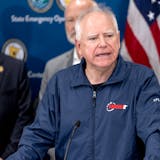Young athletes are no longer required to wear masks in outdoor competitions for COVID-19 prevention, state health officials said Thursday while urging them, and all middle and high school students, to seek testing to slow the pandemic.
While key indicators of pandemic activity such as hospitalizations have leveled off, the Minnesota Department of Health reported a record 1,088 infections with the coronavirus that causes COVID-19 among pre-K-12 students in the week ending April 17.
Only 10% of infections in children and teens produce severe illness, but the rest can fuel viral spread, state Health Commissioner Jan Malcolm said. "Even a mildly ill or completely asymptomatic child can transmit the virus to more vulnerable people in their family or broader community."
Testing is advised every two weeks for middle and high school students, and every week for athletes, referees and coaches. To increase access, the state on Thursday offered to provide school districts and sports clubs with free mail-in kits to test students and athletes.
"We all want to make sure that our students can have the prom and graduation ceremonies and everything else that comes with an end of a great school year," said Heather Mueller, state Education Commissioner and a mother of two high school students. "Testing is one of the ways to be able to get that."
Relief from outdoor mask-wearing was requested last week by an advisory panel of the Minnesota State High School League. Masks under the new policy are optional for athletes in outdoor games or matches but still required for most indoor team competitions and for anyone on the sidelines or benches.
The move drew measured support from Let Them Play MN, an advocacy group that opposed Minnesota's pause on youth athletics in November and the mask-wearing and restrictions that followed when play resumed in January.
The group in a lawsuit alleged that Minnesota lacked scientific proof that sports presented elevated risk of viral transmission or posed a risk of spreading the virus to vulnerable elderly or long-term care residents. It also documented instances of injuries when athletes lacked visibility or couldn't breathe during competition.



